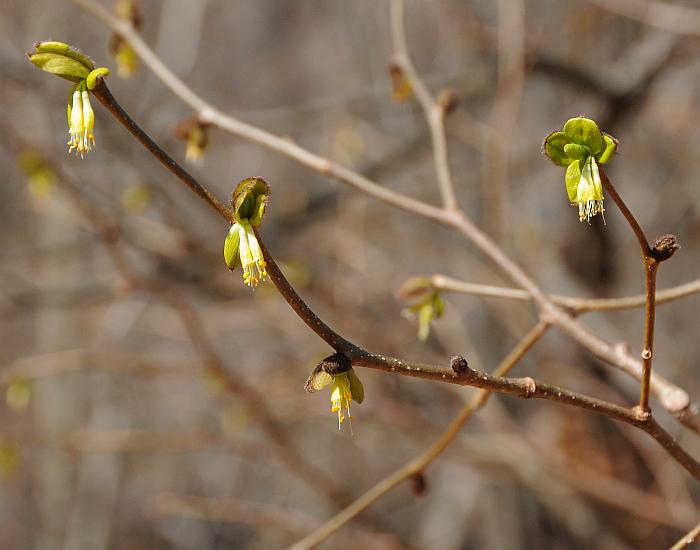Dirca palustris L.
Leatherwood

Native
CC = 8
CW = 0
MOC = 33
© SRTurner
Dirca palustris L.Leatherwood | |
 |
Native CC = 8 CW = 0 MOC = 33 |
© SRTurner |
|
Family - Thymelaeaceae Habit - Shrub to 2 m. Stems - Multiple from base, to 2 m, freely branching, the bark usually light grayish brown. Twigs 2-4 mm wide, yellowish brown or occasionally reddish brown, jointed, glabrous, expanding at nodes and buds, flexible, the nodes typically with a small spur.
Leaves - Alternate, simple, short-petiolate, deciduous. Petioles 1-5 mm long, densely appressed-hairy. Blades 2-10 cm long (those of the persistent pair of leaflike bracts at the base of each year's growth shorter), rounded or broadly angled to a bluntly or less commonly sharply pointed tip, rounded or angled at the base, the margins glabrous or sparsely to moderately hairy (0-8 hairs per mm).
Inflorescence - Small clusters, typically with 2-4 flowers, appearing before the new leaves. Individual flowers with glabrous stalks 1-10 mm long (sometimes 2 or more of the stalks in a cluster fused nearly to the tips), elongating slightly as the fruits mature. Persistent bracts 5-10 mm at flowering, continuing to enlarge to 35 mm or more as the fruits develop, oblong-obovate to narrowly oblong-obovate, the adaxial surface glabrous or sparsely hairy along the veins, the abaxial surface woolly with dense, dark brown hairs.
Flowers - Calyces 5-8 mm long, appearing nearly tubular, consisting of a basal hypanthium and a slightly expanded, petaloid (yellow to lemon yellow), apical portion (the limb) formed from 4 fused sepals, the margin irregular and/or minutely scalloped, not persistent at fruiting. Corollas absent. Stamens 8, exserted, the filaments of 2 lengths, attached in a ring to the inner surface of the calyx above the hypanthium portion, the anthers small, attached basally, yellow. Pistil 1 per flower, appearing composed of 1 carpel, the superior ovary sometimes with a minute, irregularly lobed nectar disc at the base. Style 1, slender, exserted and extending slightly beyond the anthers, not persistent at fruiting, the stigma 1, minute, capitate. Ovules 1, the placentation more or less basal.
Fruits - Drupes 8-12 mm long, ovoid to ellipsoid-ovoid, glabrous at the tip.
Flowering - March - April. Habitat - Bottomland and mesic forests, streambanks, bluff bases. Origin - Native to the U.S. Lookalikes - D. decipiens, which is probably much rarer in Missouri. Other info. - This distinctive shrub is found mainly in the Ozark region of Missouri. Its range extends in somewhat scattered fashion throughout the eastern half of the continental U.S. and into Canada. When in flower, the plant is easily identified by its small, pendent flowers and woolly bracts; however, differentiation from the closely related D. decipiens can be tricky. That species reportedly has flowers which are sessile or nearly so; in D. palustris they are usually borne on short but easily discernible stalks. Another clue is habitat, as D. decipiens is found in dryer, upland sites. Photographs taken in the Hercules Glade Wilderness, Mark Twain National Forest, Taney County, MO., 4-8-01 (DETenaglia); also at Little Lost Creek Conservation Area, Warren County, MO, 3-22-2015, 4-1-2015, 4-1-2019, 4-14-2021, and 6-27-2023 (SRTurner). |